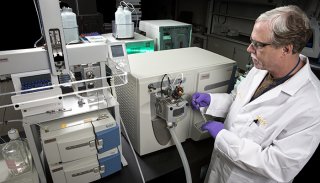CWA Analytical Methods for Per- and Polyfluorinated Alkyl Substances (PFAS)

The EPA developed two new analytical methods to test for PFAS compounds in wastewater, as well as other environmental media.
- Background
- Method 1633A for 40 PFAS Compounds
- Method 1621 for Adsorbable Organic Fluorine
- Documents
- Related Information
Background
There are thousands of different PFAS chemicals of varying carbon chain lengths and different functional groups. Analyzing them in a comprehensive way has been a challenge that scientists at all levels of government are working to address. Different offices within the EPA have published methods to test for certain PFAS in drinking water and in non-potable water and continues to work on methods for other matrices. The methods described below are the result of the efforts of the Clean Water Act Methods Program.
Method 1633A for 40 PFAS Compounds
The EPA’s Office of Water, in partnership with the Department of Defense’s (DoD) Strategic Environmental Research and Development Program, has published Method 1633A, “Analysis of Per- and Polyfluoroalkyl Substances (PFAS) in Aqueous, Solid, Biosolids, and Tissue Samples by LC-MS/MS,” a method to test for 40 PFAS compounds in wastewater, surface water, groundwater, soil, biosolids, sediment, landfill leachate, and fish tissue. This method can be used in various applications, including National Pollutant Discharge Elimination System (NPDES) permits. The method will support NPDES implementation by providing a consistent PFAS method that has been tested in a wide variety of wastewaters and contains all the required quality control (QC) procedures for the Clean Water Act (CWA). While the method is not nationally required for CWA compliance monitoring until the EPA has promulgated it through rulemaking, the EPA recommends it now for use in individual permits.
DoD led the multi-laboratory validation study of the procedure in collaboration with the EPA Office of Water, the Office of Land and Emergency Management, and the Office of Research and Development. The Office of Water used the results of the multi-laboratory validation study to finalize the method and add formal performance criteria. The Office of Water encourages laboratories, regulatory authorities, and other interested parties to review and use the method, with the understanding that it may undergo revision during a rulemaking process.
The EPA is grateful for the constructive feedback received from multiple interested parties to date, which resulted in many of the changes reflected in the final method. The items in the previously posted errata table have been addressed in the December 2024 version of EPA Method 1633A (available in the Documents section below). Method 1633A was proposed for approval at 40 CFR Part 136.3 in December 2024 (docket number EPA-HQ-OW-2024-0328). However, Method 1633A is not nationally required for CWA compliance monitoring until the EPA has promulgated it through rulemaking.
Method 1621 for Adsorbable Organic Fluorine
The EPA’s Office of Water has published Method 1621, “Determination of Adsorbable Organic Fluorine (AOF) in Aqueous Matrices by Combustion Ion Chromatography (CIC),” a method to measure the aggregate concentration of organofluorines (molecules with a carbon-fluorine bond) in wastewater. The most common sources of organofluorines are PFAS and non-PFAS fluorinated compounds such as certain pesticides and pharmaceuticals.
AOF is a method-defined parameter, meaning that the results of the measurement are dependent on the manner in which the measurement is made. The method does not quantify all of the organofluorine it captures with the same accuracy and has some known interferences that are discussed in the first section of the method. The method tells the user that organofluorines are present but cannot identify which specific organofluorines are present. The strength of the method is that it can broadly screen for thousands of known PFAS compounds at the part-per-billion level in aqueous (water) samples.
The Office of Water led a multi-laboratory validation study of Method 1621. The Office of Water used the results of the multi-laboratory validation study to finalize the method and develop formal performance criteria. The Office of Water encourages interested parties to review and use the method, with the understanding that it may undergo revision during a rulemaking process. Method 1621 was proposed for approval at 40 CFR Part 136.3 in December 2024 (docket number EPA-HQ-OW-2024-0328). However, Method 1621 is not nationally required for CWA compliance monitoring until the EPA has promulgated it through rulemaking.
Documents
Single-Laboratory Validation Study of PFAS by Isotope Dilution LC-MS/MS (pdf)
